Spatial Distribution and Changes of the Realizable Triple Cropping System in China
Abstract
:1. Introduction
2. Materials and Methods
2.1. Study Area
2.2. Data Sources
2.3. Methods
2.3.1. Definition and Conceptual Framework for Assessing the Spatial Distribution of the RTCS
2.3.2. Calculation of Annual Accumulated Temperature and Precipitation
2.3.3. Estimating the Impact of Topography on Key Climate Elements
2.3.4. Crop Climatic-Ecological Suitability Assessment Model
2.3.5. Verification Method of the RTCS Based on Cask Theory
3. Results
3.1. The Influence of Topography on the RTCS
3.2. Response of the RTCS to Climate Change
3.3. Distribution of the RTCS Based on Crop Climatic-Ecological Suitability
3.4. Verification of the Distribution of RTCS in China
4. Discussion
4.1. Influences of Climate Change and Terrain on Changes between Potential TCS and RTCS
4.2. Understanding the Gap between Actual TCS and RTCS Caused by Socio-Economic Factors
5. Conclusions
Author Contributions
Funding
Conflicts of Interest
References
- Guilpart, N.; Grassini, P.; Sadras, V.O.; Timsina, J.; Cassman, K.G. Estimating yield gaps at the cropping system level. Field Crops Res. 2017, 206, 21–32. [Google Scholar] [CrossRef] [PubMed]
- Tirlapur, L.N.; Mundinamani, S.M. An economic analysis on land use and cropping pattern in Dharwad district. Int. Res. J. Agric. Econ. Stat. 2015, 6, 176–181. [Google Scholar] [CrossRef]
- Struik, P.C.; Kuyper, T.W. Editorial overview: Sustainable intensification to feed the world: Concepts, technologies and trade-offs. Curr. Opin. Environ. Sustain. 2014, 8, VI–VIII. [Google Scholar] [CrossRef]
- Smith, P. Delivering food security without increasing pressure on land. Glob. Food Secur. 2013, 2, 18–23. [Google Scholar] [CrossRef]
- Francis, C.A. Importance of multiple-species systems. Biological efficiencies in multiple-cropping systems. In Advances in Agronomy; Academic Press: Lincoln, NE, USA, 1989; Volume 42, pp. 1–42. [Google Scholar]
- Guo, J.P.; Zhao, J.F.; Xu, Y.H.; Chu, Z.; Mu, J.; Zhao, Q. Effects of adjusting cropping systems on utilization efficiency of climatic resources in Northeast China under future climate scenarios. Phys. Chem. Earth 2015, 87–88, 87–96. [Google Scholar] [CrossRef]
- Yan, H.M.; Xiao, X.M.; Huang, H.Q.; Liu, J.Y.; Chen, J.Q.; Bai, X.H. Multiple cropping intensity in China derived from agro-meteorological observations and MODIS data. Chin. Geogr. Sci. 2013, 24, 205–219. [Google Scholar] [CrossRef]
- Yu, Q.Y.; Wu, W.B.; You, L.Z.; Zhu, T.J.; van Vliet, J.; Verburg, P.H.; Liu, Z.H.; Li, Z.G.; Yang, P.; Zhou, Q.B.; et al. Harvested area gaps in China. Agric. Syst. 2017, 153, 212–220. [Google Scholar] [CrossRef]
- Zuo, L.J.; Wang, X.; Zhang, Z.X.; Zhao, X.L.; Liu, F.; Yi, L.; Liu, B. Developing grain production policy in terms of multiple cropping systems in China. Land Use Policy 2014, 40, 140–146. [Google Scholar] [CrossRef]
- Biradar, C.M.; Xiao, X.M. Quantifying the area and spatial distribution of double-and triple-cropping croplands in India with multi-temporal MODIS imagery in 2005. Int. J. Remote Sens. 2011, 32, 367–386. [Google Scholar] [CrossRef]
- Panigrahy, S.; Manjunath, K.R.; Ray, S.S. Deriving cropping system performance indices using remote sensing data and GIS. Int. J. Remote Sens. 2005, 26, 2595–2606. [Google Scholar] [CrossRef]
- Quilty, J.R.; Mckinley, J.; Pede, V.O.; Buresh, R.J.; Correa, T.Q., Jr.; Sandroa, J.M. Energy efficiency of rice production in farmers’ fields and intensively cropped research fields in the Philippines. Field Crops Res. 2014, 168, 8–18. [Google Scholar] [CrossRef]
- Xiao, X.M.; Boles, S.; Liu, J.Y.; Zhuang, D.F.; Frolking, S.; Li, C.S.; Salas, W.; Moore, B. Mapping paddy rice agriculture in southern China using multi-temporal MODIS images. Land Use Policy 2005, 95, 480–492. [Google Scholar] [CrossRef]
- Seifert, C.A.; Lobell, D.B. Response of double cropping suitability to climate change in the United States. Environ. Res. Lett. 2015, 10, 024002. [Google Scholar] [CrossRef] [Green Version]
- Cohn, A.S.; Van Wey, L.K.; Spera, S.A.; Mustard, J.F. Cropping frequency and area response to climate variability can exceed yield response. Nat. Clim. Chang. 2016, 6, 601–604. [Google Scholar] [CrossRef]
- Estel, S.; Kuemmerle, T.; Levers, C.; Baumann, M.; Hostert, P. Mapping cropland use intensity across Europe using MODIS NDVI time series. Environ. Res. Lett. 2016, 11, 024015. [Google Scholar] [CrossRef]
- Niedertscheider, M.; Kastner, T.; Fetzel, T.; Haberl, H.; Kroisleitner, C.; Plutzar, C.; Erb, K.H. Mapping and analysing cropland use intensity from a NPP perspective. Environ. Res. Lett. 2016, 11, 014008. [Google Scholar] [CrossRef] [Green Version]
- Ray, D.K.; Foley, J.A. Increasing global crop harvest frequency: Recent trends and future directions. Environ. Res. Lett. 2013, 8, 044041. [Google Scholar] [CrossRef]
- Zabel, F.; Putzenlechner, B.; Mauser, W. Global agricultural land resources—A high resolution suitability evaluation and its perspectives until 2100 under climate change conditions. PLoS ONE 2014, 9, e107522. [Google Scholar] [CrossRef]
- Xiang, M.T.; Yu, Q.Y.; Wu, W.B. From multiple cropping index to multiple cropping frequency: Observing cropland use intensity at a finer scale. Ecol. Indic. 2019, 101, 892–903. [Google Scholar] [CrossRef]
- Wu, W.B.; Yu, Q.Y.; You, L.Z.; Chen, K.; Tang, H.J.; Liu, J.G. Global cropping intensity gaps: Increasing food production without cropland expansion. Land Use Policy 2018, 76, 515–525. [Google Scholar] [CrossRef]
- Wang, J.Y.; Zhang, Z.W.; Liu, Y.S. Spatial shifts in grain production increases in China and implications for food security. Land Use Policy 2018, 74, 204–213. [Google Scholar] [CrossRef]
- Gray, J.; Friedl, M.; Frolking, S.; Ramankutty, N.; Nelson, A.; Guma, M.K. Mapping Asian cropping intensity with MODIS. IEEE J. Sel. Top. Appl. Earth Obs. Remote Sens. 2014, 7, 3373–3379. [Google Scholar] [CrossRef]
- Plourde, J.D.; Pijanowski, B.C.; Pekin, B.K. Evidence for increased monoculture cropping in the Central United States. Agric. Ecosyst. Environ. 2013, 165, 50–59. [Google Scholar] [CrossRef]
- Beets, W.C. Introduction. In Multiple Cropping and Tropical Farming Systems; Westview Press: Boulder, CO, USA, 1982; pp. 14–26. [Google Scholar]
- Gaba, S.; Lescourret, F.; Boudsocq, S.; Enjalbert, J.; Hinsinger, P.; Journet, E.P.; Navas, M.L.; Wery, J.; Louarn, G.; Malézieux, E.; et al. Multiple cropping systems as drivers for providing multiple ecosystem services: From concepts to design. Agron. Sustain. Dev. 2015, 35, 607–623. [Google Scholar] [CrossRef]
- Hayami, Y.; Ruttan, V.W. Agricultural Development: An International Perspective; Johns Hopkins University Press: Baltimore, MD, USA, 1985. [Google Scholar]
- Turner, B.L.; Doolittle, W.E. The concept and measure of agricultural intensity. Prof. Geogr. 1978, 30, 297–301. [Google Scholar] [CrossRef]
- Turner, B.L.; Hanham, R.Q.; Portararo, A.V. Population pressure and agricultural intensity. Ann. Assoc. Am. Geogr. 1977, 67, 384–396. [Google Scholar]
- Ye, Q.; Yang, X.G.; Dai, S.W.; Chen, G.S.; Li, Y.; Zhang, C.X. Effects of climate change on suitable rice cropping areas, cropping systems and crop water requirements in southern China. Agric. Water Manag. 2015, 159, 35–44. [Google Scholar] [CrossRef]
- Wang, F.T. Impact of climate change on cropping system and its implication for agriculture in China. Acta Meteorol. Sin. 1997, 11, 407–415. [Google Scholar]
- Yang, X.G.; Liu, Z.J.; Chen, F. The possible effects of global warming on cropping systems in China I. The possible effects of climatic warming on northern limits of cropping systems and crop yields in China. Sci. Agric. Sin. 2010, 43, 329–336, (In Chinese with English abstract). [Google Scholar]
- Li, Y.J.; Wang, C.Y. Impacts of climate change on crop planting structure in China. Adv. Clim. Chang. Res. 2010, 6, 123–129, (In Chinese with English abstract). [Google Scholar]
- Ju, H.; Velde, M.; Lin, E.; Xiong, W.; Li, Y.C. The impacts of climate change on agricultural production systems in China. Clim. Chang. 2013, 120, 313–324. [Google Scholar] [CrossRef]
- Yang, X.G.; Liu, Z.J.; Chen, F. The possible effect of climate warming on northern limits of cropping system and crop yield in China. Agric. Sci. Chin. 2011, 10, 585–594. [Google Scholar] [CrossRef]
- Zhao, J.; Yang, X.G.; Liu, Z.J.; Chen, D.F.; Wang, W.F.; Chen, F. The possible effect of global climate changes on cropping systems boundary in China II. The characteristics of climatic variables and the possible effect on northern limits of cropping systems in South China. Sci. Agric. Sin. 2010, 43, 1860–1867, (In Chinese with English abstract). [Google Scholar]
- Li, Y.; Yang, X.G.; Ye, Q.; Chen, F. The possible effects of global warming on cropping systems in China IX. The risks of high and low temperature disasters for single and double rice and its impacts on rice yield in the Middle-Lower Yangtze Plain. Sci. Agric. Sin. 2013, 46, 3997–4006. (In Chinese) [Google Scholar]
- Yang, X.G.; Chen, F.; Lin, X.M.; Liu, Z.J.; Zhao, J.; Li, K.N.; Ye, Q.; Li, Y.; Lv, S.; Yang, P.; et al. Potential benefits of climate change for crop productivity in China. Agric. For. Meteorol. 2015, 208, 76–84. [Google Scholar] [CrossRef]
- Cao, M.K.; Ma, S.J.; Han, C.R. Potential productivity and human carrying capacity of an agro-ecosystem: An analysis of food production potential of China. Agric. Syst. 1995, 47, 387–414. [Google Scholar] [CrossRef]
- Jain, M.; Mondal, P.; Defries, R.S.; Small, C.; Galford, G.L. Mapping cropping intensity of smallholder farms: A comparison of methods using multiple sensors. Remot. Sens. Environ. 2013, 134, 210–223. [Google Scholar] [CrossRef]
- Liu, X.H.; Han, X.L. China’s Multi-Cropping; Beijing Agricultural University Press: Beijing, China, 1987. (In Chinese) [Google Scholar]
- Duan, H.P. Analysis of the development of Hunan farming system from 1949 to 1998. Crop Plant 2001, 3, 1–4. (In Chinese) [Google Scholar]
- Zuo, L.J.; Wang, X.; Liu, F.; Yi, L. Spatial exploration of multiple cropping efficiency in China based on time series remote sensing data and econometric model. J. Integr. Agric. 2013, 12, 903–913. [Google Scholar] [CrossRef]
- Liu, L.; Xu, X.L.; Zhuang, D.F.; Chen, X.; Li, S. Changes in the potential multiple cropping system in response to climate change in China from 1960–2010. PLoS ONE 2013, 8, e80990. [Google Scholar] [CrossRef]
- Verburg, P.H.; Chen, Y.Q.; Veldkamp, T.A. Spatial explorations of land use change and grain production in China. Agric. Ecosyst. Environ. 2000, 82, 333–354. [Google Scholar] [CrossRef]
- Wang, Q.X.; Otsubo, K.; Ichinose, T. Estimation of Potential and Convertible Arable Land in China. 2001. Available online: http://www.researchgate.net/ publication/274296271 (accessed on 11 March 2019).
- Fan, J.L.; Wu, B.F. A study on cropping index potential based on GIS. J. Remote Sens. 2004, 8, 637–644. (In Chinese) [Google Scholar]
- Sun, Q.L.; Feng, X.F.; Ge, Y.; Li, B.L. Topographical effects of climate data and their impacts on the estimation of net primary productivity in complex terrain: A case study in Wuling mountainous area, China. Ecol. Inform. 2015, 27, 44–54. [Google Scholar] [Green Version]
- Bryan, B.A.; Adams, J.M. Three-Dimensional Neurointerpolation of Annual Mean Precipitation and Temperature Surfaces for China. Geogr. Anal. 2002, 34, 93–111. [Google Scholar] [CrossRef] [Green Version]
- Daly, C. Guidelines for assessing the suitability of spatial climate data sets. Int. J. Climatol. 2006, 26, 707–721. [Google Scholar] [CrossRef] [Green Version]
- Wang, G.Q.; Zhang, B.; Zhang, Y.Z.; Tang, M.; Ma, B. Variation tendency of accumulated temperature in Gansu Province in recent 55 years. Res. Soil Water Conserv. 2016, 23, 193–198, (In Chinese with English abstract). [Google Scholar]
- Sun, W.; Zhu, Y.Q.; Huang, S.L.; Guo, C.X. Mapping the mean annual precipitation of China using local interpolation techniques. Theor. Appl. Climatol. 2014, 119, 171–180. [Google Scholar] [CrossRef]
- Wang, R.J.; Li, X.B.; Tan, M.H.; Xin, L.J.; Wang, S.; Wang, Y.H.; Jiang, M. Inter-provincial differences in rice multi-cropping changes in double-cropping rice area in China: Evidence from Provinces and Households. Chin. Geogr. Sci. 2019, 29, 127–138. [Google Scholar] [CrossRef]
- Gong, Z.P.; Ma, C.M. Farming System; China Hydraulic Press: Beijing, China, 2013. (In Chinese) [Google Scholar]
- Fischer, G.; Velthuizen, H.V.; Shah, M.; Nachtergaele, F. Agro-ecological Methodology and Results. In Global Agro-Ecological Assessment for Agriculture in the 21st Century; International Institute for Applied Systems Analysis: Rome, Italy; Food and Agriculture Organization of the United Nations: Laxenburg, Austria, 2002; pp. 6–103. [Google Scholar]
- Dong, J.W.; Liu, J.Y.; Tao, F.L.; Xu, X.L.; Wang, J.B. Spatio-temporal changes in annual accumulated temperature in China and the effects on cropping systems. Clim. Res. 2009, 40, 37–48. [Google Scholar] [CrossRef]
- Zhang, R.R.; Chen, X.; Wang, H.M.; Cheng, Q.B.; Zhang, Z.C.; Shi, P. Temporal change of spatial heterogeneity and its effect on regional trend of annual precipitation heterogeneity indices. Hydrol. Proc. 2017, 31, 3178–3190. [Google Scholar] [CrossRef]
- Xie, P.; Li, H.Q.; Ye, A.Z. A lake eutrophication stochastic assessment method by using empirical frequency curve and its verification. J. Lake Sci. 2004, 16, 371–376, (In Chinese with English abstract). [Google Scholar]
- Villarín, M.C. Methodology based on fine spatial scale and preliminary clustering to improve multivariate linear regression analysis of domestic water consumption. Appl. Geogr. 2019, 103, 22–39. [Google Scholar] [CrossRef]
- Dai, S.P.; Li, H.L.; Luo, H.X.; Liu, H.Q.; Cao, J.H. Spatial simulation of AAT10 (active accumulated temperature ≥10 °C) based on Multiple Linear Regression Model. Chin. J. Trop. Agric. 2014, 34, 54–59, (In Chinese with English abstract). [Google Scholar]
- Samanta, S.; Pal, D.K.; Lohar, D.; Pal, B. Interpolation of climate variables and temperature modeling. Theor. Appl. Climatol. 2012, 107, 35–45. [Google Scholar] [CrossRef]
- Zhang, G.L.; Dong, J.W.; Zhou, C.P.; Xu, X.L.; Wang, M.; Ouyang, H.; Xiao, X.M. Increasing cropping intensity in response to climate warming in Tibetan Plateau, China. Field Crops Res. 2013, 142, 36–46. [Google Scholar] [CrossRef]
- Li, J. Science of Farming System; Science Press: Beijing, China, 2016. (In Chinese) [Google Scholar]
- Wang, B.S. Plant Physiology, 3rd ed.; Science Press: Beijing, China, 2017. (In Chinese) [Google Scholar]
- Wei, T.Y.; Glomsrød, S.; Zhang, T.Y. Extreme weather, food security and the capacity to adapt—The case of crops in China. Food Secur. 2015. [Google Scholar] [CrossRef]
- Liu, S.L.; Pu, C.; Ren, Y.X.; Zhao, X.L.; Zhao, X.; Chen, F.; Xiao, X.P.; Zhang, H.L. Yield variation of double-rice in response to climate change in Southern China. Eur. J. Agron. 2016, 81, 161–168. [Google Scholar] [CrossRef]
- Huang, J.K.; Wang, Y.J.; Wang, J.X. Farmer’s adaptation to extreme weather events through farm management and its Impacts on the Mean and Risk of Rice Yield in China. Am. J. Agric. Econ. 2015, 97, 602–617. [Google Scholar] [CrossRef]
- Zhang, T.Y.; Yang, X.G.; Wang, H.S.; Li, Y.; Ye, Q. Climatic and technological ceilings for Chinese rice stagnation based on yield gaps and yield trend pattern analysis. Glob. Chang. Biol. 2014, 20, 1289–1298. [Google Scholar] [CrossRef]
- Yang, L.C.; Qin, Z.H.; Tu, L.L. Responses of rice yields in different rice-cropping systems to climate variables in the middle and lower reaches of the Yangtze River, China. Food Secur. 2015, 7, 951–963. [Google Scholar] [CrossRef]
- Lesk, C.; Rowhani, P.; Ramankutty, N. Influence of extreme weather disasters on global crop production. Nature 2016, 529, 84–87. [Google Scholar] [CrossRef] [PubMed]
- Wassmann, R.; Jagadish, S.V.K.; Sumfleth, K.; Pathak, H.; Howell, G.; Ismail, A.; Serraj, R.; Redona, E.; Singh, R.K.; Heuer, S. Regional vulnerability of climate change impacts on Asian rice production and scope for adaptation. Adv. Agron. 2009, 102, 91–133. [Google Scholar]
- Zhang, S.A.; Tao, F.L.; Zhang, Z. Changes in extreme temperatures and their impacts on rice yields in southern China from 1981 to 2009. Field Crops Res. 2016, 189, 43–50. [Google Scholar] [CrossRef] [Green Version]
- Li, Y.; Yang, X.G.; Dai, S.W.; Wang, W.F. Spatiotemporal change characteristics of agricultural climate resources in middle and lower reaches of Yangtze River. Chin. J. Appl. Ecol. 2010, 21, 2912–2921, (In Chinese with English abstract). [Google Scholar]
- Christian, K. Alpine plant life: Functional plant ecology of high mountain ecosystems. Mt. Res. Dev. 2003, 21. [Google Scholar] [CrossRef]
- Barry, R.G.; Chorley, R.J. Atmosphere, Weather and Climate, 5th ed.; Routledge: London, UK, 1987. [Google Scholar]
- Dierig, D.A.; Adam, N.R.; Mackey, B.E.; Dahlquist, G.H.; Coffelt, T.A. Temperature and elevation effects on plant growth, development, and seed production of two Lesquerella species. Ind. Crops Prod. 2006, 24, 17–25. [Google Scholar] [CrossRef]
- Cao, G.C.; Wu, D.B.; Li, J.X.; Zhang, C.Q.; Zhao, Z. Effect of latitude and altitude on the growth and development of Wheat. South Chin. J. Agric. Sci. 1993, 6, 1–11. (In Chinese) [Google Scholar]
- Xu, X.L.; Liu, L. Cropping rotation system data of China. Acta Geogr. Sin. 2014, 69, 144–148, (In Chinese with English abstract). [Google Scholar]
- Zhou, D.Y.; An, P.L.; Pan, Z.H.; Zhang, F.R. Arable land use intensity change in China from 1985 to 2005: Evidence from integrated cropping systems and agro economic analysis. J. Agric. Sci. 2012, 150, 179–190. [Google Scholar] [CrossRef]
- Grassini, P.; Eskridge, K.M.; Cassman, K.G. Distinguishing between yield advances and yield plateaus in historical crop production trends. Nat. Commun. 2013, 4, 2918. [Google Scholar] [CrossRef]
- Iizumi, T.; Ramankutty, N. How do weather and climate influence cropping area and intensity? Glob. Food Secur. 2015, 4, 46–50. [Google Scholar] [CrossRef] [Green Version]
- Rode, S. Effects of Urbanisation on Multiple Cropping Patterns in Coastal Districts of India; S. K. Somaiya College: Vidyavihar, India, 2011; pp. 4–15. [Google Scholar]
- Zheng, X.Y.; Xu, Z.G.; Ying, R.Y. Regional heterogeneity in the changes of grain production in the context of urbanization and structural adjustment in China. China Soft Sci. 2014, 11, 71–86, (In Chinese with English abstract). [Google Scholar]
- The National Development and Reform Commission (NDRC). Compilation of Cost and Income Data of National Agricultural Products; China Statistics Press: Beijing, China, 2015. (In Chinese) [Google Scholar]
- Shao, J.A.; Zhang, S.C.; Li, X.B. Farmland marginalization in the mountainous areas: Characteristics, influencing factors and policy implications. Acta Geogr. Sin. 2014, 69, 227–242, (In Chinese with English abstract). [Google Scholar] [CrossRef]
- Wang, X.B.; Yamauchi, F.; Huang, J.K.; Rozelle, S. What constrains mechanization in Chinese agriculture? Role of farm size and fragmentation. Chin. Econ. Rev. 2018. [Google Scholar] [CrossRef]
- Cooper, G.; McGechan, M.B.; Vinten, A.J.A. The influence of a changed climate on soil workability and available workdays in Scotland. J. Agric. Eng. Res. 1997, 68, 253–269. [Google Scholar] [CrossRef]
- Liang, S.M. Probing potentials of multiple cropping index in the selected Provinces in China. Issues Agric. Econ. 2007, 5, 85–90. (In Chinese) [Google Scholar]
- Deng, Z.Y.; Zhang, Q.; Pu, J.Y. The impact of climate warming on crop planting and production in northwestern China. Acta Ecol. Sin. 2008, 28, 3760–3768. [Google Scholar]
- Yang, H.; Li, X.B. Cultivated land and food supply in China. Land Use Policy 2000, 17, 73–88. [Google Scholar] [CrossRef]

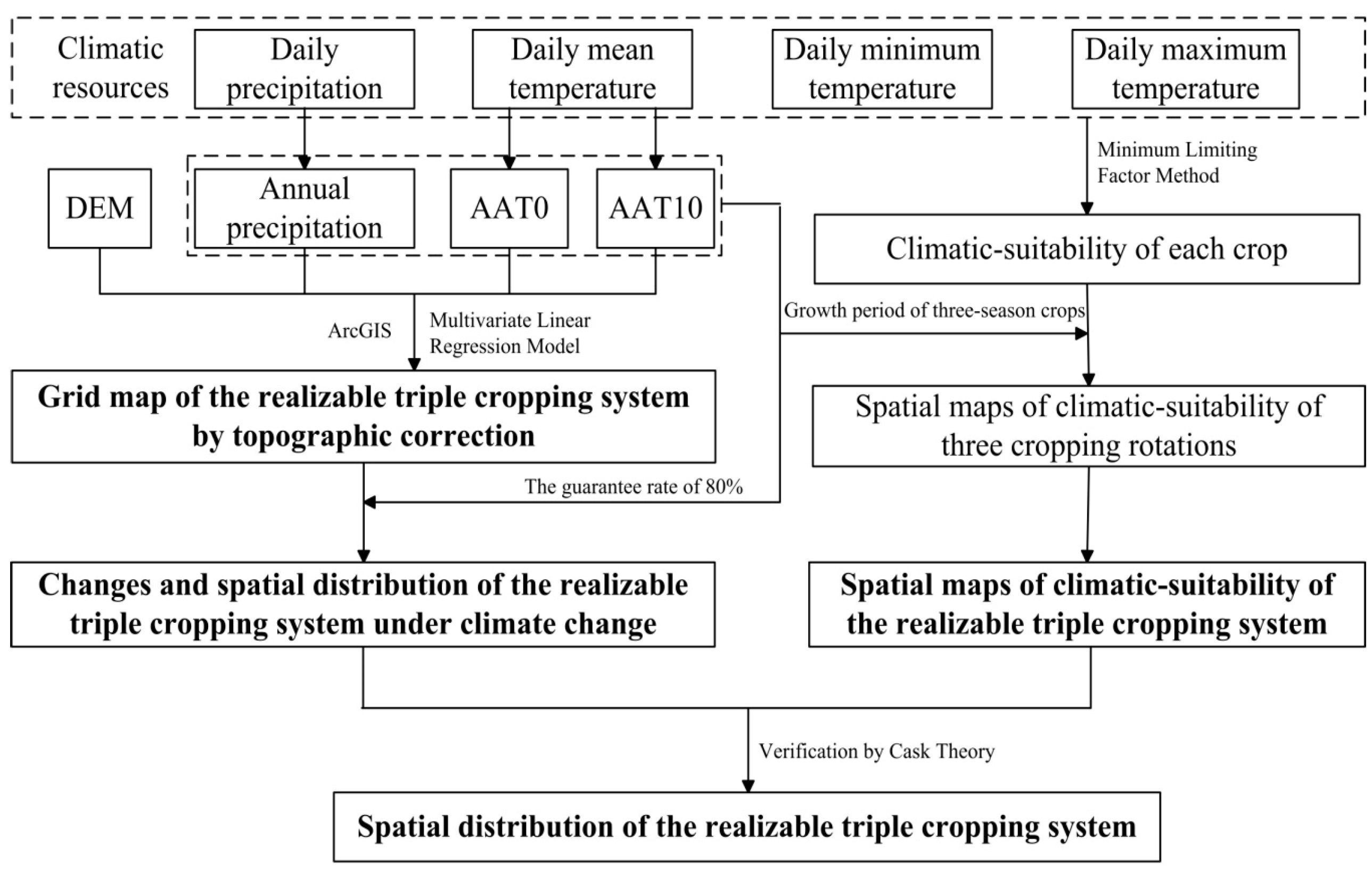
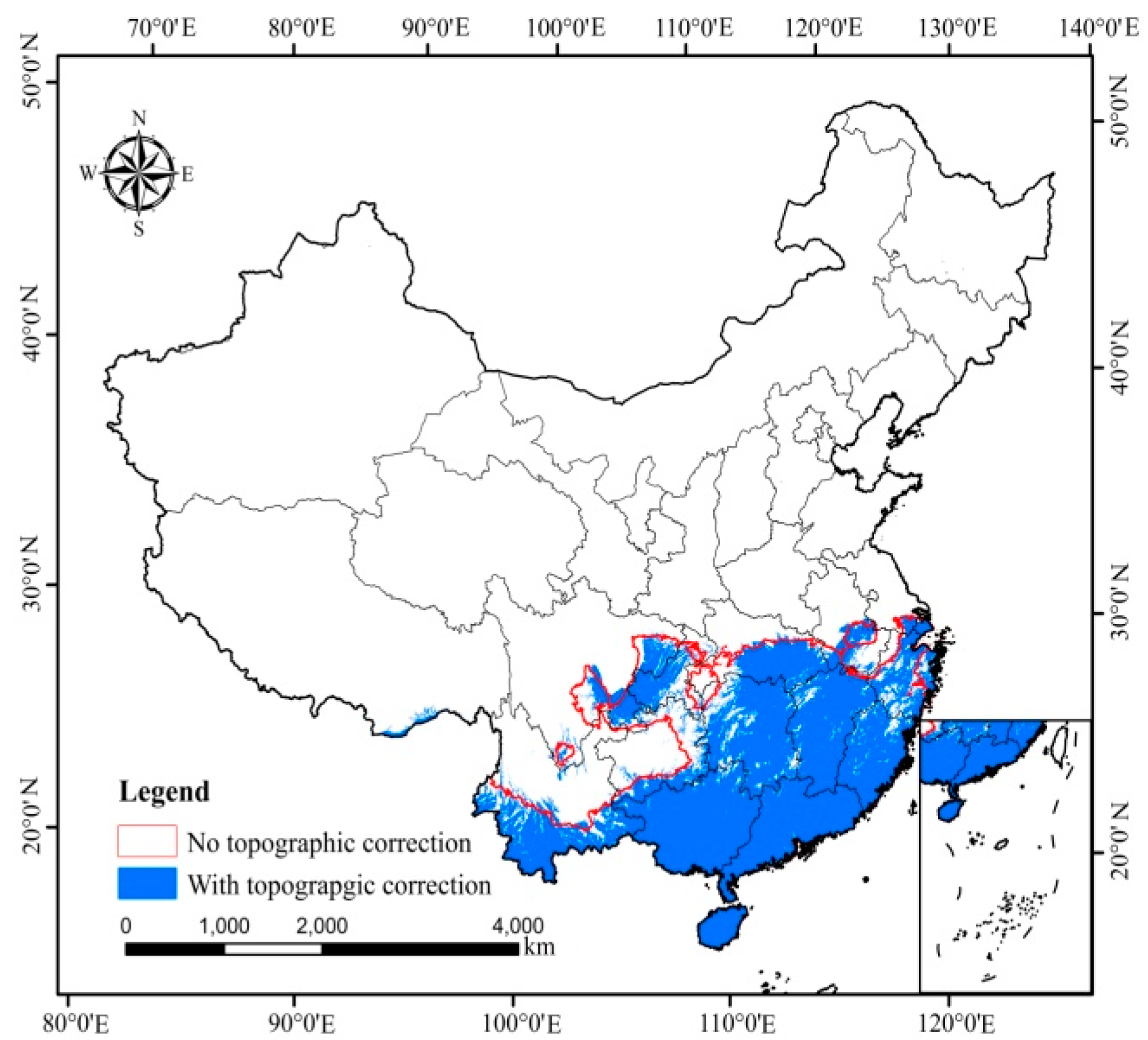
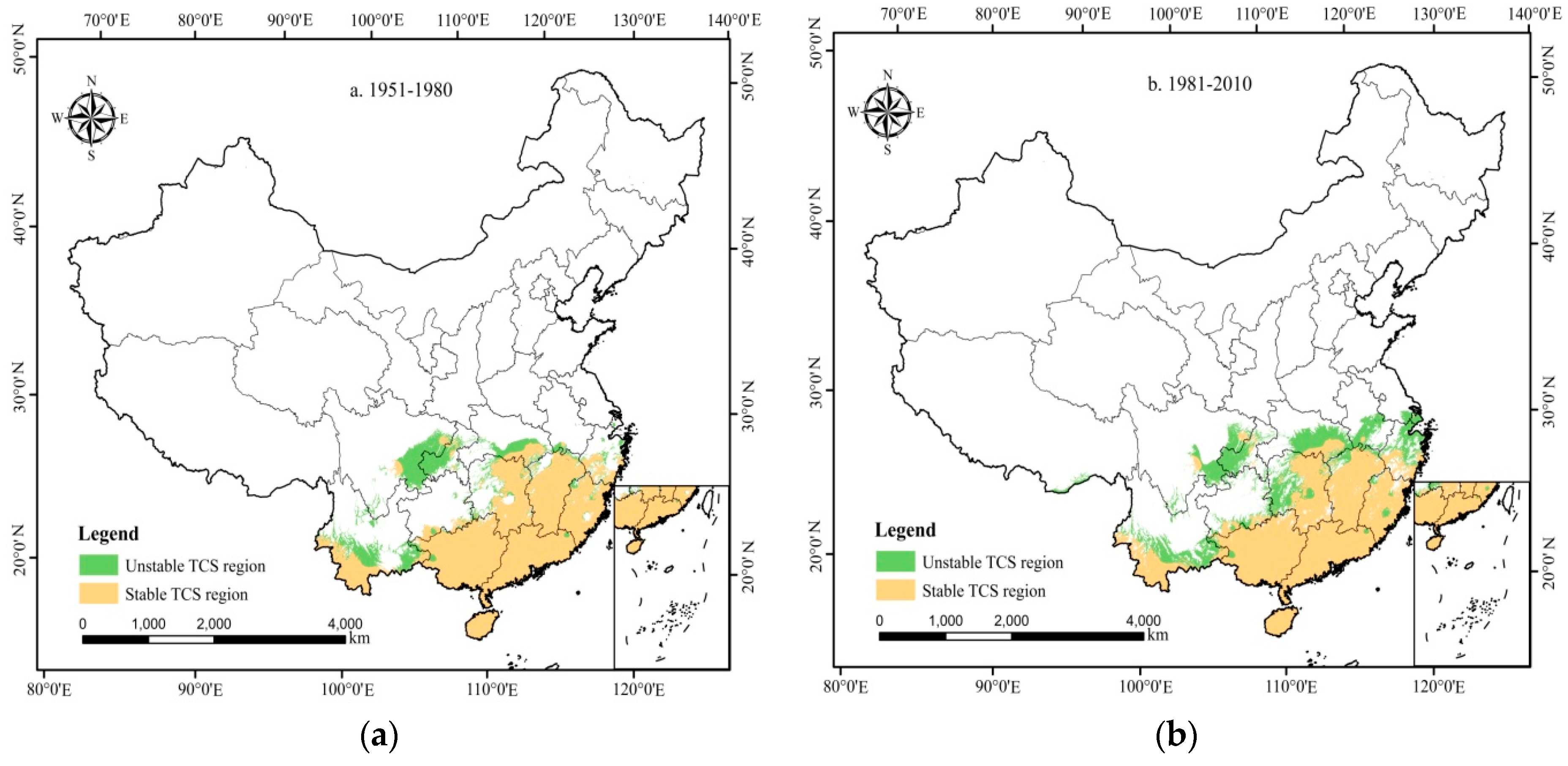
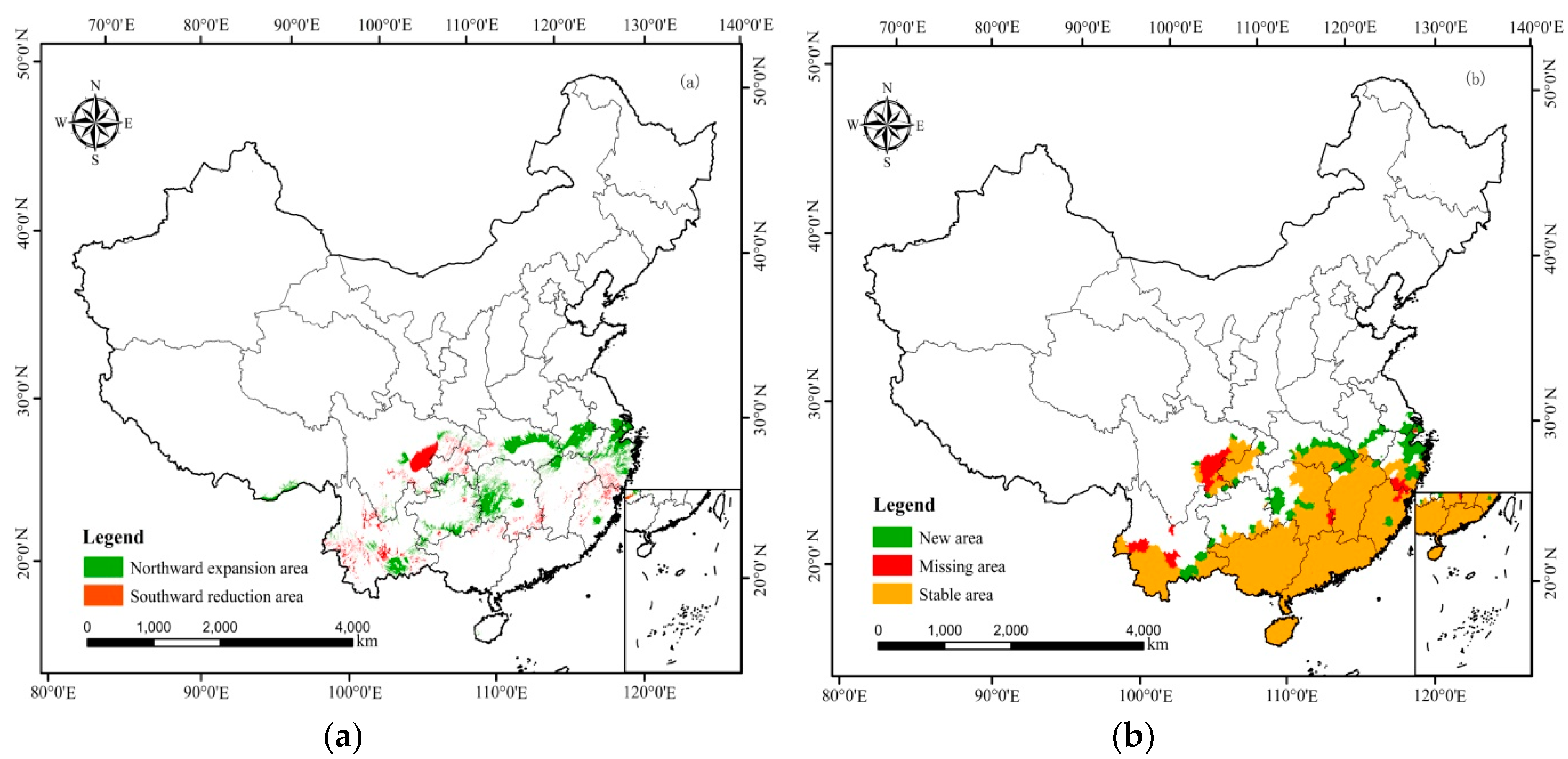
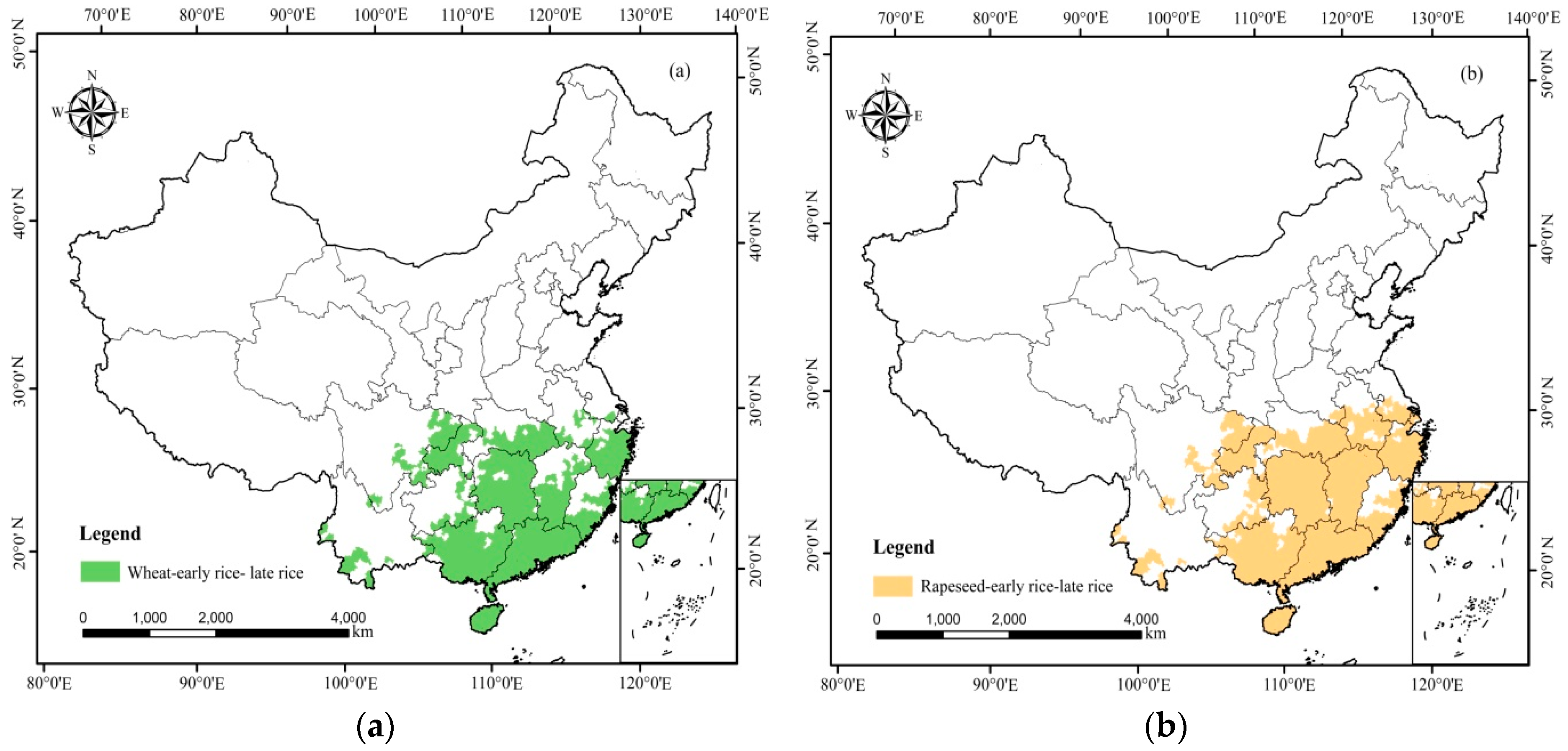
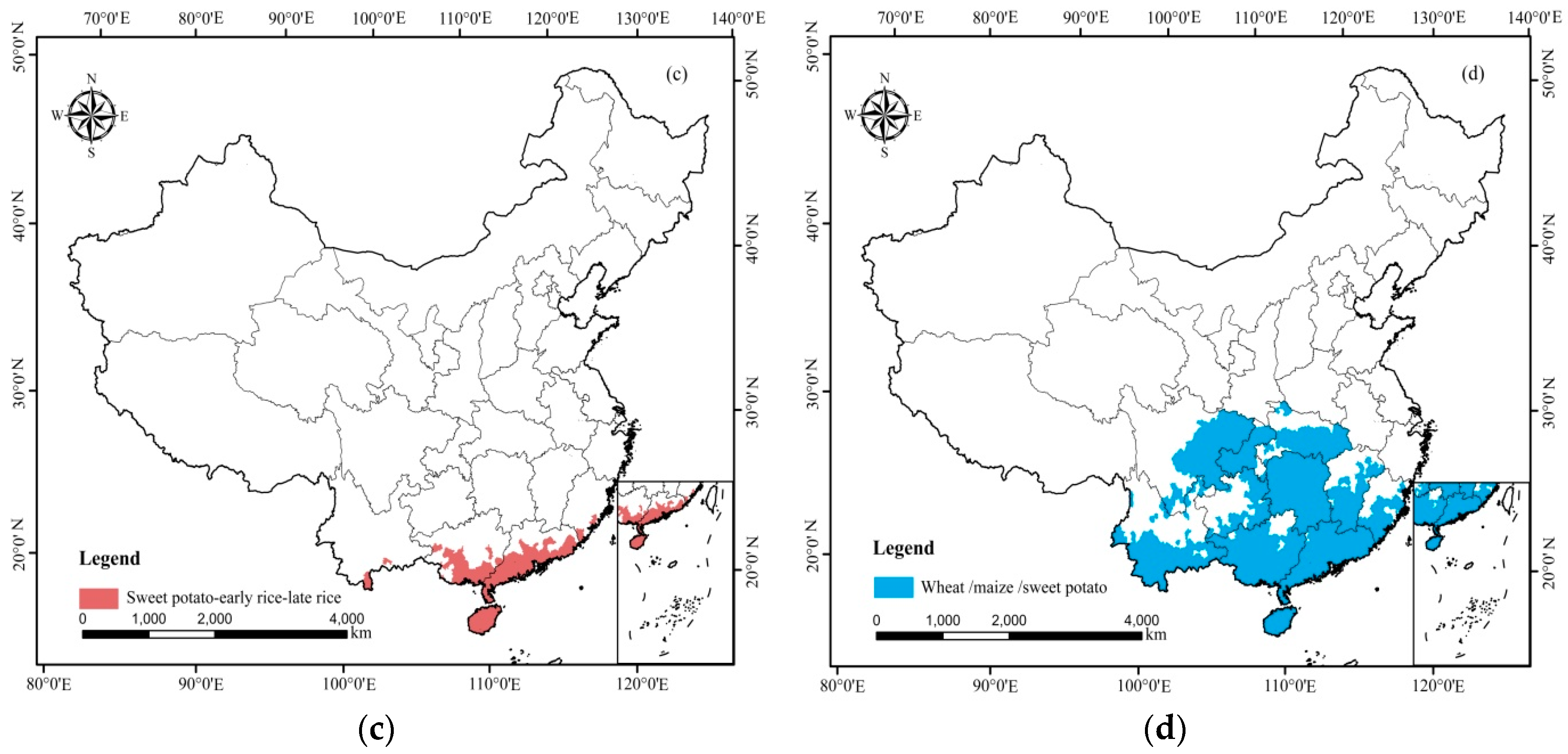
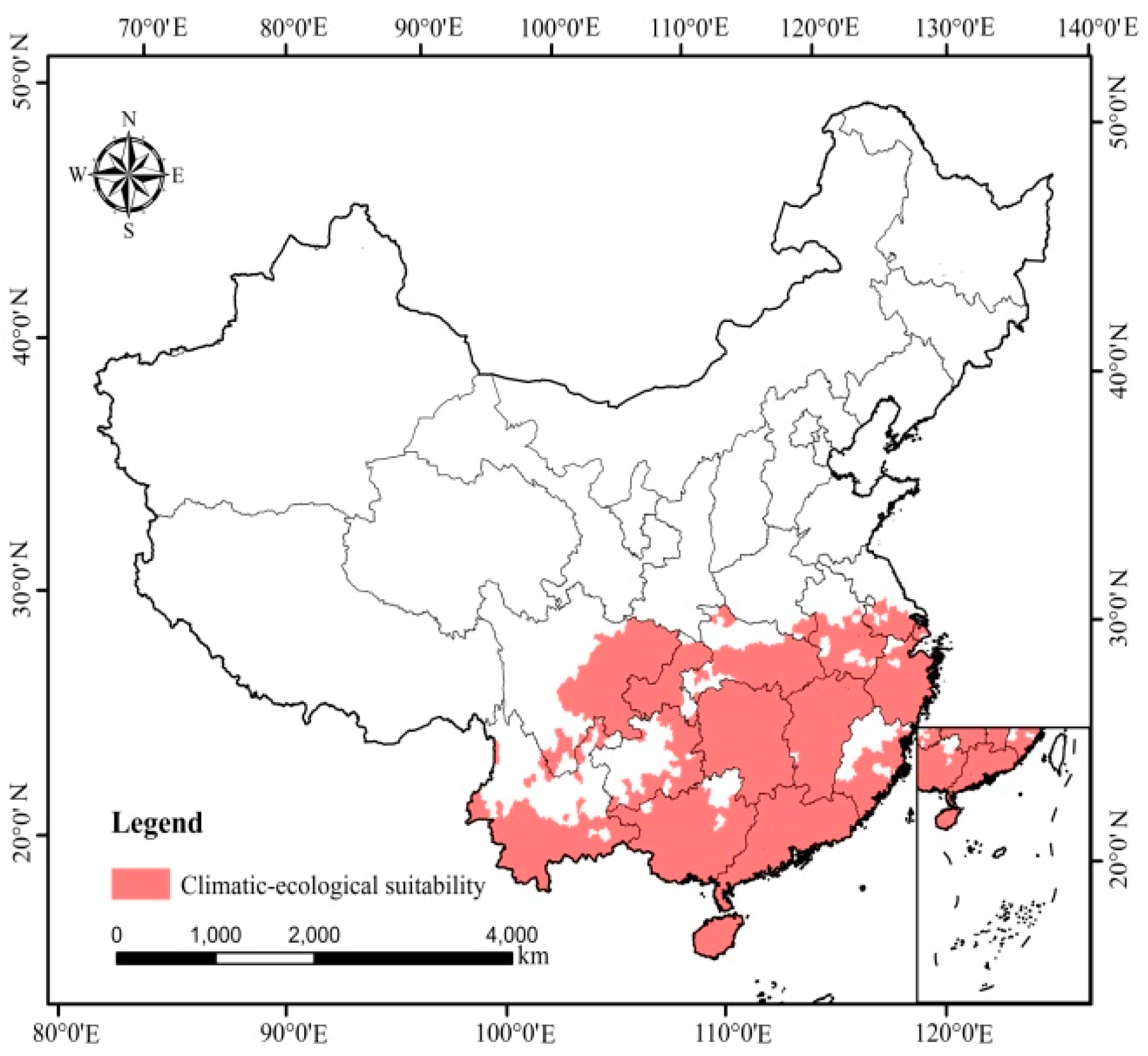

| Test Indicators | Period of 1950–80 | Period of 1981–2010 | |||||
|---|---|---|---|---|---|---|---|
| AAT0 | AAT10 | Precipitation | AAT0 | AAT10 | Precipitation | ||
| Independence | Durbin–Watson | 1.384 | 1.308 | 1.165 | 1.110 | 0.863 | 0.981 |
| Normality | Standard Deviation | 0.998 | 0.998 | 0.992 | 0.999 | 0.999 | 0.999 |
| Homoscedasticity | Sig. | 0.000 | 0.000 | 0.000 | 0.000 | 0.000 | 0.000 |
| Non-collinearity | Tolerance | 0.717 (J) 1, 0.987 (W) 2, 0.725 (H) 3 | 0.722 (J), 0.988 (W), 0.730 (H) | 0.649 (J), 0.972 (W), 0.694 (H) | 0.545 (J), 0.897 (W), 0.581 (H) | 0.545 (J), 0.897 (W), 0.581 (H) | 0.545 (J), 0.897 (W), 0.581 (H) |
| Crop Type | AAT0 (°C·d) | AAT10 (°C·d) | Precipitation (mm) | Average Temperature During Growth Duration (°C) | Temperature Thresholds of Seed Germination (°C) | ||
|---|---|---|---|---|---|---|---|
| PT 6 | MinT 7 | MaxT 8 | |||||
| Winter wheat | 1800–2600 | 1600–1700 | — | — | 25–31 | 0–5 | 31–37 |
| Maize | — | 2000–3000 | 500–1000 | ≥10 | 32–35 | 8–10 | 40–45 |
| Double rice | — | ≥4500 | >1000 | ≥20 | 30–37 | 10–12 | 40–42 |
| Rapeseed | — | 2000–3000 (s) 4 1400–2500 (t) 5 | — | — | 20–25 | 3–5 | 35–37 |
| Sweet potato | — | 2200–4000 | — | — | 13 | 15–25 | 30 |
| Periods | Indices | Regression Equation | R | R2 |
|---|---|---|---|---|
| 1951–1980 | AAT0 | AAT0 = 12,580.414 − 9.578J *,9 − 181.545W * − 0.771H * | 0.924 | 0.853 |
| AAT10 | AAT10 = 123,580.625 − 11.525J * − 180.188W * − 0.835H * | 0.916 | 0.839 | |
| P | P = 1444.047 + 12.376J * − 56.199W * − 0.125H * | 0.930 | 0.863 | |
| 1981–2010 | AAT0 | AAT0 = 15,598.316 − 33.497J * − 178.781W * − 1.266H * | 0.977 | 0.954 |
| AAT10 | AAT10 = 15,331.076 − 35.081J * − 177.794W * − 1.346H * | 0.956 | 0.914 | |
| P | P = 1291.441 + 16.646J * − 66.165W * − 0.093H * | 0.895 | 0.801 |
| Verification Point | Feasture | Climatic Resources | Growth Period of Crops | Sown Area in 1990 (ha) | Cropping Rotations | |||
|---|---|---|---|---|---|---|---|---|
| AAT0 | AAT10 | P | Crops | Start and End Dates (Month/Ten Days) | ||||
| (°C·d) | (°C·d) | (mm) | ||||||
| Yixiu District | The lowest AAT0 | 5902 | 5468 | 1417 | Rapeseed | Oct./last-May/first 10 | — 14 | RRR |
| Early rice | May/first-Jul./middle | |||||||
| Late rice | Jul./last-Oct./last | |||||||
| Wheat | Jul./last-Oct./middle 11 | WRR | ||||||
| Early rice | Nov./middle-May/middle | |||||||
| Late rice | Jul./last-Oct./last | |||||||
| Qiubei County | The lowest AAT10 | 5913 | 5409 | 1050 | Wheat | Nov./first-Apr./first 12 | 2166 | WMS |
| Maize | Apr./middle-Aug./first | 17,873 | ||||||
| Sweet potato | Aug./last-Oct./last | 2646 | ||||||
| Junlian County | The lowest P | 5994 | 5528 | 1027 | Wheat | Nov./first-May/first 13 | 5713 | WMS |
| Maize | May/first-Aug./middle | 10,240 | ||||||
| Sweet potato | Aug./middle-Nov./first | 1140 | ||||||
© 2019 by the authors. Licensee MDPI, Basel, Switzerland. This article is an open access article distributed under the terms and conditions of the Creative Commons Attribution (CC BY) license (http://creativecommons.org/licenses/by/4.0/).
Share and Cite
Jiang, L.; Chen, X.; Lun, F.; Pan, Z.; Niu, J.; Ding, C.; Meng, L.; Zhang, G.; Mgeni, C.P.; Sieber, S.; et al. Spatial Distribution and Changes of the Realizable Triple Cropping System in China. Sustainability 2019, 11, 1654. https://doi.org/10.3390/su11061654
Jiang L, Chen X, Lun F, Pan Z, Niu J, Ding C, Meng L, Zhang G, Mgeni CP, Sieber S, et al. Spatial Distribution and Changes of the Realizable Triple Cropping System in China. Sustainability. 2019; 11(6):1654. https://doi.org/10.3390/su11061654
Chicago/Turabian StyleJiang, Li, Xin Chen, Fei Lun, Zhihua Pan, Jiaheng Niu, Chenyang Ding, Lijun Meng, Guoliang Zhang, Charles Peter Mgeni, Stefan Sieber, and et al. 2019. "Spatial Distribution and Changes of the Realizable Triple Cropping System in China" Sustainability 11, no. 6: 1654. https://doi.org/10.3390/su11061654






